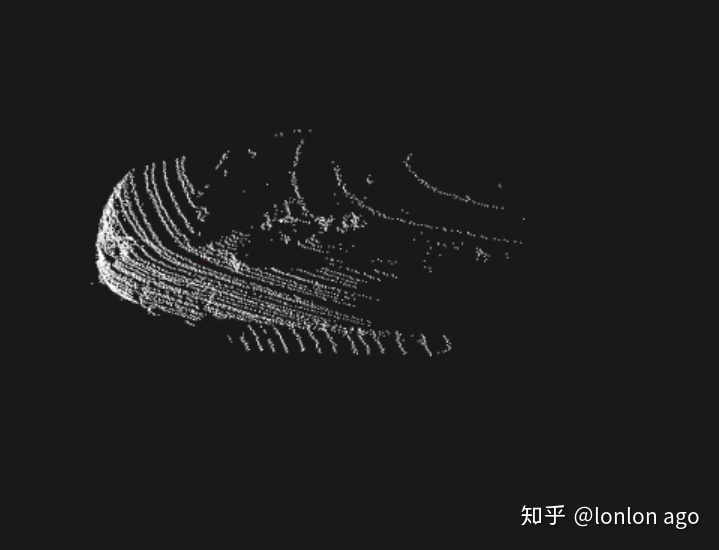目前需要对点云障碍物进行初步的分类,所以要根据 kitti 标签的点云坐标,提取其在整帧点云中的某个障碍物数据,比如汽车,行人的点云数据;
问题在于点云的标签居然是在图像坐标系中的,所以我们需要先把图像坐标转换为激光雷达坐标系,
然后根据label中的长宽高获取其AABB包围盒,
最后提取包围盒中的点的数据,然后存储就行了;
代码如下:
def get_kitti_object_cloud_v2():
save_object_cloud_path = r'D:KITTIObjecttrainingobject_cloud'
for img_id in range(7481):
lidar_path = r'D:KITTIObjecttrainingvelodyne%06d.bin' % img_id ## Path ## need to be changed
label_path = r'D:KITTIObjecttraininglabel_2%06d.txt' % img_id ## Path ## need to be changed
calib_path = r'D:KITTIObjecttrainingcalib%06d.txt' % img_id
points = np.fromfile(lidar_path, dtype=np.float32).reshape(-1, 4) # .astype(np.float16)
lables = np.loadtxt(label_path,
dtype={'names': ('type', 'truncated', 'occuluded', 'alpha', 'xmin', 'ymin', 'xmax', 'ymax', 'h', 'w', 'l', 'x', 'y', 'z','rotation_y'),
'formats': ('S14', 'float', 'float', 'float', 'float', 'float', 'float', 'float','float', 'float', 'float', 'float', 'float', 'float', 'float')})
calibs = Calibration(calib_path)
if lables.size == 1:
lables = lables[np.newaxis]
i = 0
for label in lables:
i += 1
if label['type'] != b'DontCare':
# 将图像坐标转换为激光点云坐标
xyz = calibs.project_rect_to_velo(np.array([[label['x'], label['y'], label['z']]]))
# 中心点
x = xyz[0][0]
y = xyz[0][1]
z = xyz[0][2]
# AABB 包围盒,最近点和最远点
min_point_AABB = [x - label['l'] / 2, y - label['w'] / 2, z, ]
max_point_AABB = [x + label['l'] / 2, y + label['w'] / 2, z + label['h'], ]
# 过滤该范围内的激光点
x_filt = np.logical_and(
(points[:,0]>min_point_AABB[0]), (points[:,0]<max_point_AABB[0]))
y_filt = np.logical_and(
(points[:,1]>min_point_AABB[1]), (points[:,1]<max_point_AABB[1]))
z_filt = np.logical_and(
(points[:,2]>min_point_AABB[2]), (points[:,2]<max_point_AABB[2]))
filt = np.logical_and(x_filt, y_filt) # 必须同时成立
filt = np.logical_and(filt, z_filt) # 必须同时成立
object_cloud = points[filt, :] # 过滤
# 转换标签,可以自定义
if label['type'] in [ b'Car', b'Van', b'Truck', b'Tram']:
adjust_label = 'vehicle'
elif label['type'] in [ b'Pedestrian', b'Person_sitting']:
adjust_label = 'Pedestrian'
elif label['type'] in [ b'Cyclist']:
adjust_label = 'Cyclist'
elif label['type'] in [ b'Misc']:
adjust_label = 'other'
# 只有 1-3 个点的记录或者没有点的记录都不要,其实还可以更加严格
if object_cloud.shape[0] <= 3:
print('filter failed...', img_id, adjust_label, i)
continue
np.save(save_object_cloud_path+'%06d-%s-%d' % (img_id, adjust_label, i),object_cloud)
其中用到的工具代码如下:
class Calibration(object):
''' Calibration matrices and utils
3d XYZ in <label>.txt are in rect camera coord.
2d box xy are in image2 coord
Points in <lidar>.bin are in Velodyne coord.
y_image2 = P^2_rect * x_rect
y_image2 = P^2_rect * R0_rect * Tr_velo_to_cam * x_velo
x_ref = Tr_velo_to_cam * x_velo
x_rect = R0_rect * x_ref
P^2_rect = [f^2_u, 0, c^2_u, -f^2_u b^2_x;
0, f^2_v, c^2_v, -f^2_v b^2_y;
0, 0, 1, 0]
= K * [1|t]
image2 coord:
----> x-axis (u)
|
|
v y-axis (v)
velodyne coord:
front x, left y, up z
rect/ref camera coord: 这两个rect/ref 是一个东西?
right x, down y, front z
Ref (KITTI paper): http://www.cvlibs.net/publications/Geiger2013IJRR.pdf
TODO(rqi): do matrix multiplication only once for each projection.
'''
def __init__(self, calib_filepath, from_video=False):
if from_video:
calibs = self.read_calib_from_video(calib_filepath)
else:
calibs = self.read_calib_file(calib_filepath)
# Projection matrix from rect camera coord to image2 coord
self.P = calibs['P2']
self.P = np.reshape(self.P, [3,4])
# Rigid transform from Velodyne coord to reference camera coord
self.V2C = calibs['Tr_velo_to_cam']
self.V2C = np.reshape(self.V2C, [3,4])
self.C2V = inverse_rigid_trans(self.V2C)
# Rotation from reference camera coord to rect camera coord
self.R0 = calibs['R0_rect']
self.R0 = np.reshape(self.R0,[3,3])
# Camera intrinsics and extrinsics
self.c_u = self.P[0,2]
self.c_v = self.P[1,2]
self.f_u = self.P[0,0]
self.f_v = self.P[1,1]
self.b_x = self.P[0,3]/(-self.f_u) # relative
self.b_y = self.P[1,3]/(-self.f_v)
def read_calib_file(self, filepath):
''' Read in a calibration file and parse into a dictionary.
Ref: https://github.com/utiasSTARS/pykitti/blob/master/pykitti/utils.py
'''
data = {}
with open(filepath, 'r') as f:
for line in f.readlines():
line = line.rstrip()
if len(line)==0: continue
key, value = line.split(':', 1)
# The only non-float values in these files are dates, which
# we don't care about anyway
try:
data[key] = np.array([float(x) for x in value.split()])
except ValueError:
pass
return data
def read_calib_from_video(self, calib_root_dir):
''' Read calibration for camera 2 from video calib files.
there are calib_cam_to_cam and calib_velo_to_cam under the calib_root_dir
'''
data = {}
cam2cam = self.read_calib_file(os.path.join(calib_root_dir, 'calib_cam_to_cam.txt'))
velo2cam = self.read_calib_file(os.path.join(calib_root_dir, 'calib_velo_to_cam.txt'))
Tr_velo_to_cam = np.zeros((3,4))
Tr_velo_to_cam[0:3,0:3] = np.reshape(velo2cam['R'], [3,3])
Tr_velo_to_cam[:,3] = velo2cam['T']
data['Tr_velo_to_cam'] = np.reshape(Tr_velo_to_cam, [12])
data['R0_rect'] = cam2cam['R_rect_00']
data['P2'] = cam2cam['P_rect_02']
return data
def cart2hom(self, pts_3d):
''' Input: nx3 points in Cartesian 笛卡尔 就是在后面加了一列 1
Oupput: nx4 points in Homogeneous by pending 1
'''
n = pts_3d.shape[0]
pts_3d_hom = np.hstack((pts_3d, np.ones((n,1))))
return pts_3d_hom
# ===========================
# ------- 3d to 3d ----------
# ===========================
def project_velo_to_ref(self, pts_3d_velo):
pts_3d_velo = self.cart2hom(pts_3d_velo) # nx4
return np.dot(pts_3d_velo, np.transpose(self.V2C))
def project_ref_to_velo(self, pts_3d_ref):
pts_3d_ref = self.cart2hom(pts_3d_ref) # nx4
return np.dot(pts_3d_ref, np.transpose(self.C2V))
def project_rect_to_ref(self, pts_3d_rect):
''' Input and Output are nx3 points '''
return np.transpose(np.dot(np.linalg.inv(self.R0), np.transpose(pts_3d_rect)))
def project_ref_to_rect(self, pts_3d_ref):
''' Input and Output are nx3 points ''' # n*3 * 3*3 > n*3 > 3*n
return np.transpose(np.dot(self.R0, np.transpose(pts_3d_ref)))
def project_rect_to_velo(self, pts_3d_rect):
''' Input: nx3 points in rect camera coord.
这部分是我要的,需要把3D坐标转换到激光雷达坐标
Output: nx3 points in velodyne coord.
'''
pts_3d_ref = self.project_rect_to_ref(pts_3d_rect)
return self.project_ref_to_velo(pts_3d_ref)
def project_velo_to_rect(self, pts_3d_velo):
pts_3d_ref = self.project_velo_to_ref(pts_3d_velo)
return self.project_ref_to_rect(pts_3d_ref)
# ===========================
# ------- 3d to 2d ----------
# ===========================
def project_rect_to_image(self, pts_3d_rect):
''' Input: nx3 points in rect camera coord.
Output: nx2 points in image2 coord.
'''
pts_3d_rect = self.cart2hom(pts_3d_rect)
pts_2d = np.dot(pts_3d_rect, np.transpose(self.P)) # nx3
pts_2d[:,0] /= pts_2d[:,2]
pts_2d[:,1] /= pts_2d[:,2]
return pts_2d[:,0:2]
def project_velo_to_image(self, pts_3d_velo):
''' Input: nx3 points in velodyne coord.
Output: nx2 points in image2 coord.
'''
pts_3d_rect = self.project_velo_to_rect(pts_3d_velo)
return self.project_rect_to_image(pts_3d_rect)
# ===========================
# ------- 2d to 3d ----------
# ===========================
def project_image_to_rect(self, uv_depth):
''' Input: nx3 first two channels are uv, 3rd channel
is depth in rect camera coord.
Output: nx3 points in rect camera coord.
'''
n = uv_depth.shape[0]
x = ((uv_depth[:,0]-self.c_u)*uv_depth[:,2])/self.f_u + self.b_x
y = ((uv_depth[:,1]-self.c_v)*uv_depth[:,2])/self.f_v + self.b_y
pts_3d_rect = np.zeros((n,3))
pts_3d_rect[:,0] = x
pts_3d_rect[:,1] = y
pts_3d_rect[:,2] = uv_depth[:,2]
return pts_3d_rect
def project_image_to_velo(self, uv_depth):
pts_3d_rect = self.project_image_to_rect(uv_depth)
return self.project_rect_to_velo(pts_3d_rect)
def rotx(t):
''' 3D Rotation about the x-axis. '''
c = np.cos(t)
s = np.sin(t)
return np.array([[1, 0, 0],
[0, c, -s],
[0, s, c]])
def roty(t):
''' Rotation about the y-axis. '''
c = np.cos(t)
s = np.sin(t)
return np.array([[c, 0, s],
[0, 1, 0],
[-s, 0, c]])
def rotz(t):
''' Rotation about the z-axis. '''
c = np.cos(t)
s = np.sin(t)
return np.array([[c, -s, 0],
[s, c, 0],
[0, 0, 1]])
def transform_from_rot_trans(R, t):
''' Transforation matrix from rotation matrix and translation vector. '''
R = R.reshape(3, 3)
t = t.reshape(3, 1)
return np.vstack((np.hstack([R, t]), [0, 0, 0, 1]))
def inverse_rigid_trans(Tr):
''' Inverse a rigid body transform matrix (3x4 as [R|t])
[R'|-R't; 0|1]
'''
inv_Tr = np.zeros_like(Tr) # 3x4
inv_Tr[0:3,0:3] = np.transpose(Tr[0:3,0:3])
inv_Tr[0:3,3] = np.dot(-np.transpose(Tr[0:3,0:3]), Tr[0:3,3])
return inv_Tr最后单个障碍物的效果如图:









 本文介绍如何从Kitti数据集中提取汽车和行人等障碍物的点云数据。首先,需要将图像坐标转换为激光雷达坐标系,接着利用标签的长宽高获取AABB包围盒,并提取包围盒内的点云数据进行存储。通过提供的代码实现,展示了单个障碍物的点云效果。
本文介绍如何从Kitti数据集中提取汽车和行人等障碍物的点云数据。首先,需要将图像坐标转换为激光雷达坐标系,接着利用标签的长宽高获取AABB包围盒,并提取包围盒内的点云数据进行存储。通过提供的代码实现,展示了单个障碍物的点云效果。














 6899
6899

 被折叠的 条评论
为什么被折叠?
被折叠的 条评论
为什么被折叠?








